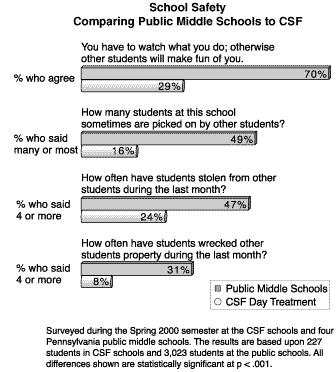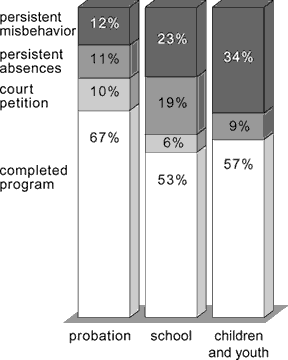Article from "Dreaming of a New Reality" conference program book by Paul McCold, director of research, and Ted Wachtel, president, of the IIRP. The article reports on the results of a 3-year evaluation of the use of a restorative practices milieu in the Community Service Foundation schools in southeastern Pennsylvania.
Plenary Speaker, Saturday, August 10, 2002From "Dreaming of a New Reality," the Third International Conference on Conferencing,
Circles and other Restorative Practices, August 8-10, 2002, Minneapolis, Minnesota
The Worst School I’ve Ever Been To is a film about the 1999-2000 school year at an alternative school in Lansdale, Pennsylvania. The film will be shown at this conference at 3 PM on Friday, August 9, in the Chippewa Room. The alternative school/day treatment program is one of six operated by the Community Service Foundation (CSF) and Buxmont Academy for delinquent and high risk youth in southeastern Pennsylvania. CSF also operates 12 residential group homes for the some of the youth who attend the schools. Additionally, CSF provides a highly structured supervision program for adjudicated delinquents who have completed inpatient drug-and-alcohol treatment, many of whom also attend the schools.
CSF and Buxmont are the two Pennsylvania non-profit agencies that created the Real Justice and Safer Saner Schools programs. In 2000 they established another non-profit organization, the International Institute for Restorative Practices. So, not surprisingly, these programs operate on a philosophy of restorative practices.
Restorative practices empower young people in each of the schools to develop their own behavioral standards, their own classroom norms and, if they persistently misbehave as individuals, their own behavioral contracts. Conflicts and problems are addressed immediately by asking the students themselves to take responsibility for finding solutions. The young people at each of the program sites consciously build a community of support, achieving interdependency and a strong sense of responsibility and concern for one another.
Two other articles in this conference book provide additional information about the CSF/Buxmont Academy school/day treatment programs. “Dreaming of a New Reality: Welcoming Remarks” defines restorative practices and provides some background. “Dreaming of a New Reality for Troubled Youth in Hungary” offers the perspective of a Hungarian psychologist who spent a school year working at the CSF/Buxmont school in Bethlehem, Pennsylvania. Also there is an extensive journal article entitled “Restorative Justice in School Communities” by David R. Karp and Beau Breslin, (Youth and Society, Vol. 33, No. 2, Dec., 2001) which talks about public schools in Colorado and Minnesota that are using various restorative practices, as well as the CSF/Buxmont schools in Pennsylvania where “restorative practices have been implemented so seamlessly in six alternative schools.”
In the 25 years since the first CSF school opened in 1977 the staff have refined strategies which seem to bring about positive behavior change. We emphasize seem because for 21 years the positive reputation of the CSF and Buxmont schools, group homes and probation supervision programs was based on anecdotal evidence only. Although people tell good stories about CSF/Buxmont and the success of kids in the programs, the results were not measured scientifically until now.
In 1998 CSF and Buxmont sought the assistance of Paul McCold, Ph.D., director of research for the International Institute for Restorative Practices, to undertake various empirical evaluations of the effectiveness of their strategies and philosophy in helping delinquent and at-risk young people achieve positive changes in behavior and attitude. McCold enlisted the support of Phil Harris, Ph.D., and Peter Jones, Ph.D., at Temple University. Harris and Jones conducted a preliminary evaluability study and found, among other things, that the staff at all levels of CSF and Buxmont have a philosophy that seems to be shared and articulated consistently throughout the two organizations.
At about the same time, independent of Harris and Jones, McCold surveyed school culture in several public schools and the CSF/Buxmont schools by asking students, parents and school staff to fill out questionnaires which included questions about their perceptions of school safety. The results were contrary to what most people would expect. Although students who attend the CSF/Buxmont schools are among the most conflict-prone and violent young people from each of their schools of origin, they feel dramatically safer and more comfortable at the CSF/Buxmont schools than do the students at the four public middle schools who participated in the survey. The comparison of the responses to four sample survey questions (see below) illustrates how much safer young people feel at all of the CSF/Buxmont schools.

In early 1999 McCold began a long-term evaluation of CSF and Buxmont students with evaluative scales and protocols provided by Criminal Justice Research Center (CJRC) at Temple University. The Center had been using these scales and protocols to evaluate programs for delinquent and at-risk serving young people from Philadelphia for almost a decade. The results from Paul McCold’s analysis of the data from the first two years of the ongoing CSF/Buxmont evaluation was subsequently confirmed by an independent analysis by Peter Jones at Temple’s CJRC completed in June, 2002. The evaluation of the CSF/Buxmont programs showed significant and positive results for all six program sites.
Paul McCold will provide a brief summary of his results just before The Worst School I’ve Ever Been To video is shown at the conference on Friday and a more detailed technical report at the conference at an 80-minute session, 10:30 AM, Saturday, August 10, in the Shoshone room. The executive summary and the full research report will be available to interested parties to download as PDF files from the International Institute for Restorative Practices web site (www.restorativepractices.org).
The study was based on a sample of 919 youths discharged from the six CSF/Buxmont school/day treatment programs between June 1, 1999 and August 30, 2001. The sample was comprised of 515 placed in the program by county juvenile probation departments, 88 by county children and youth agencies and 315 by public school districts.
Program Completion
Probation-referred students were significantly more likely to complete the program satisfactorily (66%) than the school-referred (53%) and children and youth agency-referred students (57%). Program completion rates for delinquent youth at CSF/Buxmont were twice that of comparable programs in the long-term Philadelphia study conducted by the Criminal Justice Research Center. Significantly, the restorative school/day treatment program worked just as well with so-called “tough kids” as with the “easier kids.”

Youth Attitudes
Researchers conducted entry and exit interviews with students in the CSF/Buxmont school/day treatment programs. The interviews included scales which measured prosocial norms and self-esteem. The youth who participated in both interviews showed a significant increase in their prosocial values. For example, the students became much more willing to take responsibility and were less likely to blame others for their misbehavior. Another example of attitude improvement is that they were much more likely to have positive regard for police officers when they left the program than when they entered. Also, those completing the program had high self-esteem scores upon discharge, regardless of their self-esteem at intake. The improvement in both measures of attitude was even greater for those spending a second year in the program.

Offending and Recidivism
Researchers examined juvenile and adult court records for 96 percent of the students for the six months following discharge to determine whether they had any court petitions during that time period. Youth discharged from the program prematurely for persistent misbehavior or persistent absences were nearly twice as likely as those discharged normally to have offended or re-offended. The proportion of youth with a court petition during the six months following discharge went down in direct relation to the number of weeks they had participated in the program. In short, the program significantly reduced offending rates, usually after the youths had spent at least three months in the program. Each week beyond the three months produced a significant further reduction in offending, with the largest decrease occurring during the fourth through sixth month of participation in the school/day treatment program, and then leveling off. Offending rates were reduced by two-thirds in six months.

Conclusion
While similar evaluations of many programs fail to show any significant results, the CSF/Buxmont study demonstrates that exposure to a restorative milieu positively improves both the attitudes and behavior of delinquent and at-risk youth, regardless of their age, gender, race, offense type or criminal history.

